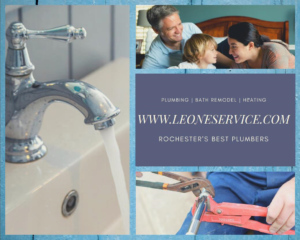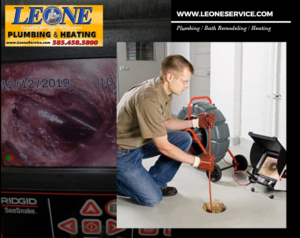
Before the advent of sewer cameras, excavation was the only option to determine the sewer lines’ condition. Digging may leave a big mess and causes inconvenience not only to you but also with nearby residences or establishment. Today, the job becomes easy with sewer cameras. Doing sewer line inspection with a camera only needs a small entry point. The sewer camera is connected to a flexible cable, and the plumber can watch through a monitor as the gadget travels through the sewer line. Our licensed plumbers now have the ability to see the undetected problems within the sewage pipe.
Common Findings Of Sewer Camera Inspection
The sewer camera findings can help us pinpoint unseen sewer line problems such as:
A single undetected crack in your sewer pipe can allow tree roots to invade your sewer line and grow into it. This will cause serious damage to your sewer line if not prevented.
Damaged Pipes
With the help of a sewer camera, unseen damaged pipes can be detected.
Bellied Sewer Line
When the sewer line starts to crumple, waste gets trapped which causes multiple blockages.
Accumulated Blockages
Over time, there can be a build-up of blockages in your sewer line. Items such as towels, feminine bathroom products, and dips in the underground plumbing due to settling dirt over the years can be detected by sewer cameras.
Types of Sewer Cameras
There are many types of sewer cameras available in the market. You can find a wide range of sewer cameras from RIDGID. We have been using
RIDGID cameras for our sewer inspection. Here are some of the camera types you can find.
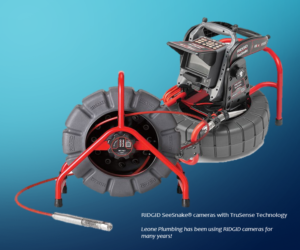
Manual Feed Black and White Camera
This is the most basic sewer pipe camera. You will only see things black and white. But if your purpose is to only look for blockages in the line, then this is useful.
Power Feed with Either Color or Black and White Camera
This camera type automatically snakes its way through the drain and pipes whenever you press a button and put the camera down the pipe to get it started. It stops when it hits a blockage. You have the option to choose a black and white or full-color video to identify what the blockage is.
Power Feed with Color Camera and Recording Features
The camera system has a recording feature that records what the camera sees in the pipe. With this type of camera, we can further study and find a better solution to solve sewer line issues. This camera has an SD memory card that plugs into a special slot inside the main compartment of the camera’s handheld monitor.
Get Your Sewer Line Inspected
If you are experiencing sewer line issues but the cause of the problem is puzzling you, then you need to get your sewer line inspected.
Contact us today to schedule a sewer line inspection.
|
Photo Credits: Leone Plumbing photos, Canva
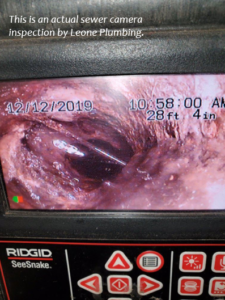
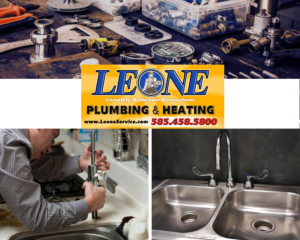 The kitchen sink drain is one of the most essential parts of your kitchen. For your kitchen to perform efficiently and smoothly, it needs to have a well-functioning plumbing system. Many homeowners are still intimidated by kitchen sink plumbing issues. It is not only inconvenient to deal with, but it can also cause serious damage to your home!
The kitchen sink drain is one of the most essential parts of your kitchen. For your kitchen to perform efficiently and smoothly, it needs to have a well-functioning plumbing system. Many homeowners are still intimidated by kitchen sink plumbing issues. It is not only inconvenient to deal with, but it can also cause serious damage to your home!
 The kitchen sink drain is one of the most essential parts of your kitchen. For your kitchen to perform efficiently and smoothly, it needs to have a well-functioning plumbing system. Many homeowners are still intimidated by kitchen sink plumbing issues. It is not only inconvenient to deal with, but it can also cause serious damage to your home!
The kitchen sink drain is one of the most essential parts of your kitchen. For your kitchen to perform efficiently and smoothly, it needs to have a well-functioning plumbing system. Many homeowners are still intimidated by kitchen sink plumbing issues. It is not only inconvenient to deal with, but it can also cause serious damage to your home!
 Before the advent of sewer cameras, excavation was the only option to determine the sewer lines’ condition. Digging may leave a big mess and causes inconvenience not only to you but also with nearby residences or establishment. Today, the job becomes easy with sewer cameras. Doing sewer line inspection with a camera only needs a small entry point. The sewer camera is connected to a flexible cable, and the plumber can watch through a monitor as the gadget travels through the sewer line. Our licensed plumbers now have the ability to see the undetected problems within the sewage pipe.
Before the advent of sewer cameras, excavation was the only option to determine the sewer lines’ condition. Digging may leave a big mess and causes inconvenience not only to you but also with nearby residences or establishment. Today, the job becomes easy with sewer cameras. Doing sewer line inspection with a camera only needs a small entry point. The sewer camera is connected to a flexible cable, and the plumber can watch through a monitor as the gadget travels through the sewer line. Our licensed plumbers now have the ability to see the undetected problems within the sewage pipe.


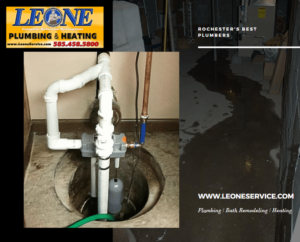 A sump pump is an important piece of equipment in your home. It prevents groundwater from entering your basement. As springtime approaches, the snow starts to melt and the water goes into people’s basements. Frequent basement flooding may cause the sump pump to fail and may require replacement. If this happens, you need a
A sump pump is an important piece of equipment in your home. It prevents groundwater from entering your basement. As springtime approaches, the snow starts to melt and the water goes into people’s basements. Frequent basement flooding may cause the sump pump to fail and may require replacement. If this happens, you need a 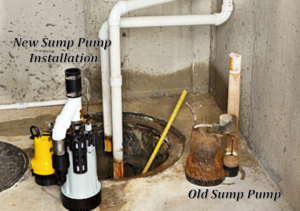 | Photo Credits:
| Photo Credits: 